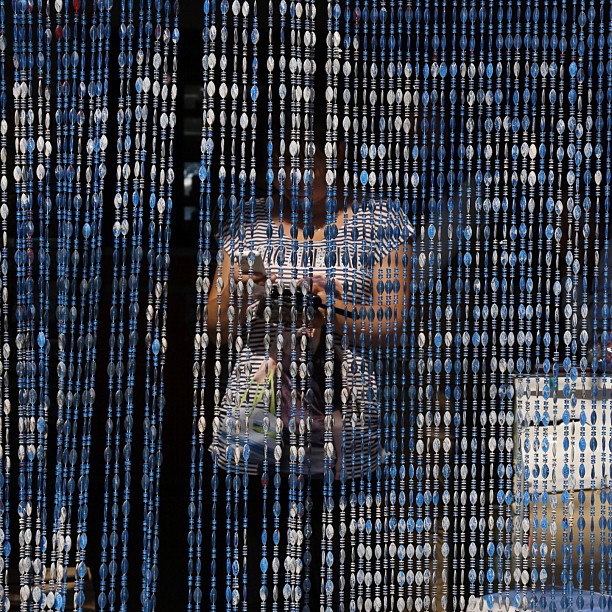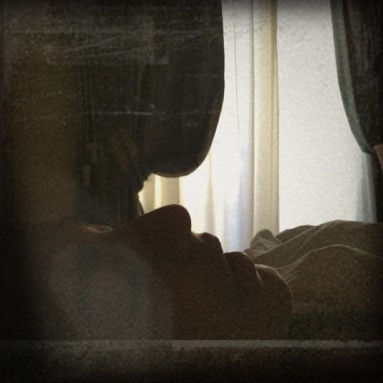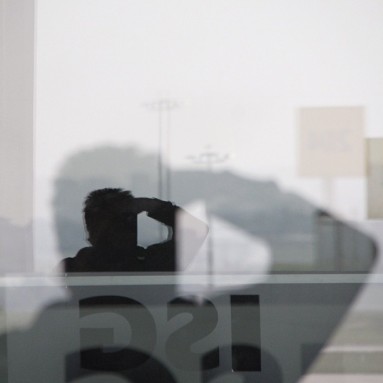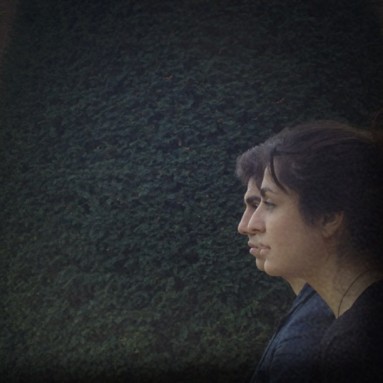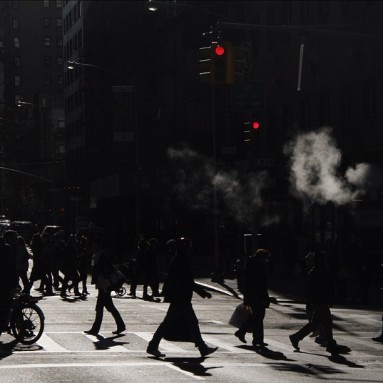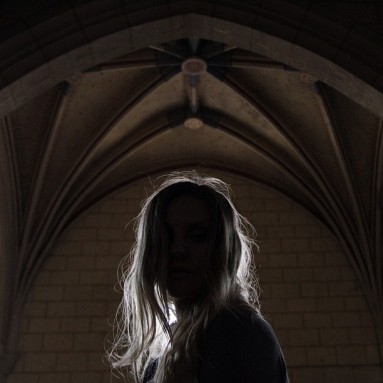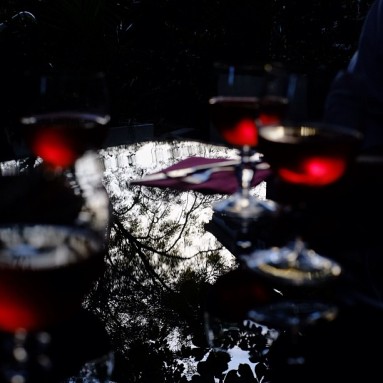We are not mayflies. We have known afternoons, and we live day after day for a great many days. This long experience of how days turn—how afternoon becomes late afternoon and late afternoon becomes night—informs any photographic work we do with natural light. The time of day at which the light is at its most glorious photographers call the golden hour: you’ve seen them toting cameras on street corners and in abandoned lots, coming at 5.30 pm or 6.30 or later, depending on the latitude and time of year. They wait for a certain intensity of shadow, for the yellow sunlight to spill just so, before it dies away into the night. But Gueorgui Pinkhassov (Russian, b. 1952, based in Paris) has done something more than wait: he has detected the golden hour in unexpected hours. A low and fractured light shimmers across his ouevre. A fluency in the language of the light at rest in all things, at rest and invisible to most eyes.
Pinkhassov’s work has come to the world in the usual way: photojournalism, print magazines, exhibitions, a book (Sightwalk, about Tokyo), and awards. He is a member of Magnum. On his art he is elusive and insightful: “The power of our Muse lies in her meaninglessness. Even the style can turn one into a slave if one does not run away from it, and then one is doomed to repeat oneself.” Thus: he changes. New approaches, new subjects, new equipment; but always rescuing the small light in things.
The work approaches abstraction. There are Soviet precedents: the spiritual energy of Tarkovsky, for whose film Stalker he shot stills in 1979; the color of Savelev, intense and pained (Goethe: “colors are the deeds and sufferings of light”); the deranged perspective of Rodchenko. Walker Evans and Friedlander too, probably, in the deadpan patterning, and Leiter, in the playing off of painterly color against shallow depths of field. But he wouldn’t be interesting if he weren’t his own man; he is, and he is. And now, in addition to his “serious” work, he is posting photos on Instagram. Instagram? I hesitate.
Digital photography and its mewling new children, Instagram among them, are causing arguments. There are studiedly old fogeys like Danny Lyon, who insist that a machine that doesn’t use film cannot be considered a camera. It’s no longer a common view: most photographers, professional or otherwise, either use digital or tacitly approve of it. Meanwhile, some serious photojournalists have reported wars and revolutions with the camera on a phone, and have won recognition for it.
The statistics beggar belief: 380 billion photos were taken in 2011, and about 10% of all the photographs currently in existence were taken in the past twelve months. Amateurs with Canon cameras and overpriced L-lenses have something to do with this; even more culpable is the incessant and overwhelming production of camera-phone images by huge numbers of people. (By the way, why is it called a “camera-phone” rather than the more logical “phone-camera”?)
There are good reasons to be suspicious of this flood of images. What is the fate of art in the age of metastasized mechanical reproduction? These are cheap images; they are in fact less than cheap, for each image costs nothing. Post-processing is easy and rampant: beautiful light is added after the fact, depth of field is manipulated, nostalgia is drizzled on in unctuous tints of orange and green. The result is briefly beguiling to the senses but ultimately annoying to the soul, like fake breasts or MSG-rich food. I like Matt Pearce’s thoughtful polemic on this subject, published on these pages: “Never before have we so rampantly exercised the ability to capture the way the world really looks and then so gorgeously disfigured it.”
But the problem with the new social photography isn’t merely about post-processing: after all, photographers have always manipulated their images in the darkroom. The filters that Hipstamatic and Instagram provide, the argument goes, are simply modern day alternatives to the dodging and burning that have always been integral to making photographs. This argument is in part true. But the rise of social photography means that we are now seeing images all the time, millions of them, billions, many of which are manipulated with the same easy algorithms, the same tiresome vignetting, the same dank green wash. So the problem is not that images are being altered—I remember the thrill I felt the first few times I saw Hipstamatic images, and I shot a few myself buoyed by that thrill—it’s that they’re all being altered in the same way: high contrasts, dewy focus, over-saturation, a skewing of the RGB curve in fairly predictable ways. Correspondingly, the range of subjects is also peculiarly narrow: pets, pretty girlfriends, sunsets, lunch. In other words, the photographic function, which should properly be the domain of the eye and the mind, is being outsourced to the camera and to an algorithm.
All bad photos are alike, but each good photograph is good in its own way. The bad photos have found their apotheosis on social media, where everybody is a photographer and where we have to suffer through each other’s “photography” the way our forebears endured terrible recitations of poetry after dinner. Behind this dispiriting stream of empty images is what Russians call poshlost: fake emotion, unearned nostalgia. According to Nabokov, poshlost "is not only the obviously trashy but mainly the falsely important, the falsely beautiful, the falsely clever, the falsely attractive.” He knows us too well.
There is of course nothing wrong with a photograph of your pug. But when you take that photograph without imaginaton and then put a “1979” filter on it—your pug wasn’t born in 1979—you are reaching for an invented past that has no relevance to the subject at hand. You make the image “better” in an empty way, thus making it worse. Your adoring fans or friends can instantly see your pug or your ham sandwich on which you have bestowed the patina of age. This immortal sandwich of yours is seen by hundreds of people even before you’ve finished eating it.
I don’t wish to begrudge anyone his or her pleasure: it’s no bad thing that everyone is now a photographer. We can be the curators of our lives, and can record every banal moment if we wish. And indeed, why not? Nevertheless, in looking at a great photographic image from the past or the present, we know when blood is drawn. We know that some images, regardless of medium, still have the power to suddenly enliven us. And we know that these images are few. Not all 350 billion images per year, not 1 billion of them, not a 100 million, not one million.
To my surprise, I joined Instagram. I did it only for Pinkhassov’s sake. I wanted to see his new images, see what a really good photographer could do with an iPhone. I wanted also to give Instagram a chance against my objections. I love new technologies as much as I am skeptical of them (I went almost straight from rotary phone to iPhone; I tend to hold out, and then I plunge). I thought at first I’d post some of my own images as well, but I decided not to, in favor of just reading others’ images.
Initially I also followed David Alan Harvey and Ed Kashi—two of the best photographers currently at work—but I found that I was more content to be following Pinkhassov alone. In Harvey’s Instagram work, as in Kashi’s, the feel is more relaxed, more domestic. Everything they post has something interesting about it, but there are many more casual, throwaway images. The selections feel less tightly edited (to see the contrast, I cannot recommend highly enough David Alan Harvey’s new book Based On a True Story, a masterful photobook shot mostly with small digital cameras). But I don’t sense this loosening of the reigns in Pinkhassov: his best Instagram images are as good as his published work; they’re made with the same seriousness, with the same sense of adventure: they are governed by the same feeling for scattered light and pensive shadow.
Robert Frank said, "When people look at my pictures I want them to feel the way they do when they want to read a line of a poem twice." I’m drawn to this poetic notion of photography, and I think Frank’s idea is what Pinkhassov, too, is after. He tries to foster the double-take of seeing. Following only him on Instagram is a bit like having a house band: what you lose in variety, you gain in reliable quality.
It’s possible to upload from your phone images taken with other cameras and saved in your image library, but Pinkhassov’s Instagram photos, as far as I can tell, are taken with the iPhone; he has long valued simplicity and immediacy. Even his print work is done with a simple Canon SLR, which should be chastening news to all the gear obsessives: no fancy Leicas or Mark IIIs here.
On Instagram he does use a filter—the images are desaturated, the color field muted, with a slight degradation of image quality—but I’m not sure which filter it is. It doesn’t matter; it’s a fairly subtle one. What I like is that a visual language is being explored with new tools. He deploys Instagram’s square format, which introduces new pressures to the organization of the picture plane. Verticality catches up with horizontality; diagonals gain new force. A peculiarity of Instagram I initially found frustrating, and which I still don’t like, is that the program is written only for phones: you upload with the phone, you view on the phone. The “original” is on that small screen alone, not on a desktop or iPad (Instagram on iPad is, for now, an unpleasant adaptation of Instagram for iPhone, with no noticeable improvement in the viewing experience), and most images are too small as files to enlarge and print out nicely.
What kind of activity are we engaging in when we look at images in a gallery? Something of that activity is certainly about participating in “culture,” about having good taste, and how good that makes us feel about ourselves. If the work exists nowhere but on the screen of an iPhone (in this case, on the screens of 2,307 iPhones—Pinkhassov’s risibly small number of Instagram followers; compare this to Dmitry Medvedev’s fifty-five thousand) then we have to adjust our expectations about the satisfactions a photograph can give. Squeezed in between sandwiches and anodyne sunsets, a Pinkhassov image (or any other image propelled by thought) must satisfy on its own merits. Thoughtfully made photographs, photographs that try to continue the conversation begun by Niépce and Atget, must somehow compete for attention among billions of other images presented in the same way. The images are not pre-credentialed by being hung on a wall at the International Center for Photography or the Leica Gallery.
We are left with optical discriminations and optical pleasures, and it is in this private space that the work regains its aura. In this sense, digital photography and social media, even though the tiny little screen can be irritating, are helping to introduce new criteria: there is no editioning, no signature, no date of printing. It will be a headache for curators in the future, but it’s a pleasure for the pure lover of the image: while lying in bed in the morning, you can see the latest work from a photographer you find interesting. The image comes to you.
I’m looking at Pinkhassov’s most recent photo on Instagram: Parc Des Buttes Chaumont. So much delicious dark. I marvel at how well his use of depth of field evokes accommodation (the way we instinctively focus on only one area of the visual field at a time). Cameras and eyes behave differently, because cameras generally can take in more in an instant; it is sometimes interesting to have cameras behave as if they are eyes, and signal with selective blurring the eyes’ imperfection. In this photo, the wine in the glasses—visible as such only on a second glance—threaten to return to the drops of blood we initially saw, just as the glass table is eager to get back to being a lake. I like scrolling through Pinkhassov’s photos in part for this constant “Wait, what is this?” effect that comes off them, even from pictures I’ve already seen five times or ten times. I love the photos that are barely there, that almost resist parsing (usually due to fragmentation combined with some stubborn confusion of foreground and background). And I love the deeper mystery of why I should find these images moving, for there is very little journalism here, and hardly any narrative, but there is much emotion, none of which feels false or brushed on.
It is the emotion of moments defended by the camera’s memory: the deposit of the experience of many afternoons and nights, of electric light and reflections, a catholicity of the visual, an inventory that includes legs, mirrors, fur, leaves, silhouettes, smoke, noses, trees, seas, windows, tiles, hair, steam, fronds, textiles. This last, the love of pattern, in particular the layering of one loudly patterned cloth against another, is a device exploited in both Keita’s studio photography and Matisse’s Orientalist paintings. In Pinkhassov’s use of it I find a similar sweet bewilderment (“Where does this end, where does that begin?”) but also something feral, hyphenated, and slightly resistant to meaning. Pinkhassov’s imagery is in this way like Hopkins’:
Glory be to God for dappled things –
For skies of couple-colour as a brinded cow;
For rose-moles all in stipple upon trout that swim;
Fresh-firecoal chestnut-falls; finches’ wings;
Landscape plotted and pieced – fold, fallow, and plough;
And áll trádes, their gear and tackle and trim.
All things counter, original, spare, strange;
Whatever is fickle, freckled (who knows how?)
With swift, slow; sweet, sour; adazzle, dim;
He fathers-forth whose beauty is past change:
Praise him.
